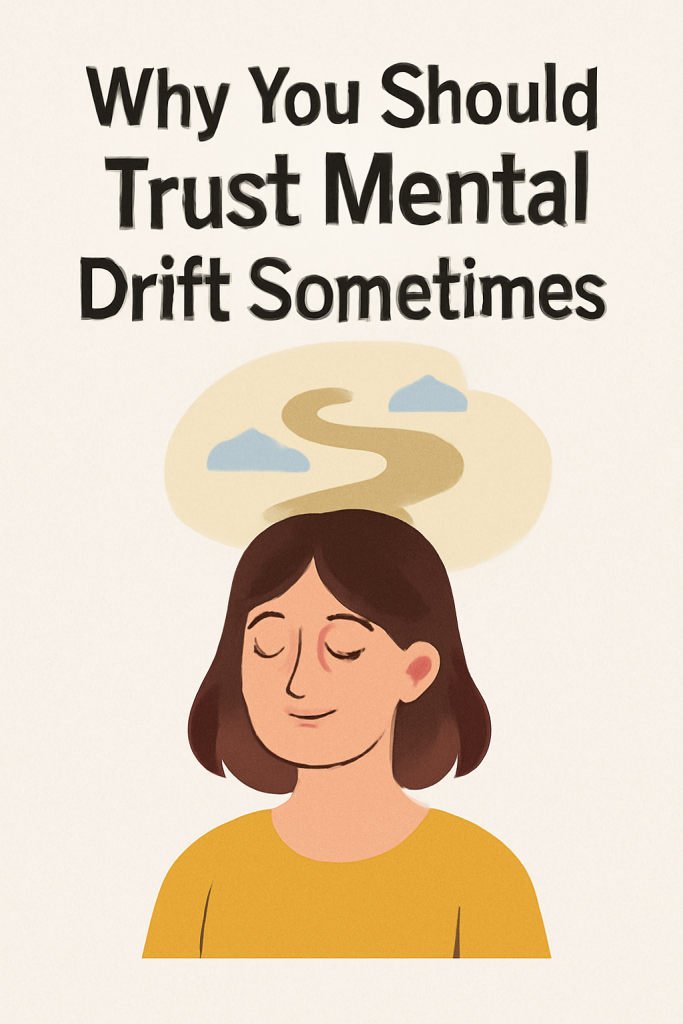In the fast-paced world we live in today, it’s easy to feel overwhelmed by constant demands on our time, attention, and energy. We’re constantly bombarded with distractions — whether from work, personal responsibilities, or the digital world. In this hyper-connected society, the idea of “mental drift” or letting our minds wander can seem counterproductive. However, recent research and emerging wellness trends suggest that allowing your mind to drift could actually be more beneficial to your mental and emotional well-being than you might think.

What is Mental Drift and Why Does it Matter?
Trusting mental drift often referred to as “mind-wandering” or “daydreaming,” is the act of letting your thoughts flow freely without any particular direction or focus. While it was once seen as a sign of lack of concentration or focus, recent studies have suggested that mind-wandering can have several positive effects, including enhancing creativity, improving problem-solving, and providing mental rest.
Let’s explore why, in some instances, trusting your mental drift can be a powerful tool for personal growth and overall well-being.
1. Why You Should Trust Mental Drift for Creativity and Problem-Solving
Research has shown that trusting mental drift plays an essential role in fostering creativity. According to a study published in Psychological Science, when people are allowed to let their minds wander, they are often able to come up with more creative solutions to problems compared to those who are focused on a task. Mind-wandering gives your brain the opportunity to make unexpected connections between disparate ideas, which is the foundation of creative thinking.
When we stop trying so hard to focus on a specific problem, our brain can access more distant memories, concepts, or ideas that we wouldn’t typically associate with the task at hand. This moment of “mental drifting” can give birth to innovative solutions and insights that could otherwise be missed. So, instead of feeling guilty about zoning out occasionally, embrace the mental drift as it might lead to your next big idea.
2. How Trusting Mental Drift Enhances Emotional Well-Being
In today’s world, we’re conditioned to be productive at all times. From the constant flow of emails to the never-ending pressure of work tasks, it’s easy to feel mentally fatigued. Trusting mental drift, however, can serve as a mental reset. A moment to pause, reflect, and disconnect from the noise can significantly reduce stress and increase emotional clarity.
Mind-wandering allows for introspection. It gives you the space to process thoughts and emotions in a way that structured thinking often doesn’t. For example, thinking about past experiences or contemplating future goals without the constraints of reality can help you gain a fresh perspective on your feelings. This can lead to improved emotional regulation, helping you navigate stress and challenges more effectively.
3. Why You Should Let Mental Drift Provide Mental Rest and Recovery
Interestingly, mental drift is more than just idle time — it serves as a form of cognitive rest. Mental rest is crucial for maintaining mental health. Just as physical rest is necessary for the body, the mind needs time to recharge and heal as well. When you allow your mind to drift, you are essentially taking a break from active mental exertion.
A study from Harvard Medical School found that the brain is highly active during mind-wandering and daydreaming. While it may appear that you’re doing nothing, your brain is still working behind the scenes to process emotions, memories, and experiences. This “rest” time helps maintain cognitive function and emotional stability, ensuring that you’re ready to tackle your next task with renewed focus and vigor.
4. The Role of Trusting Mental Drift in Personal Growth and Self-Reflection
Sometimes, the key to personal growth is stepping back and giving yourself the mental space to reflect on your experiences. Trusting mental drift offers an opportunity for deep self-reflection and exploration of your goals, values, and desires. By simply letting your mind wander, you might come to realizations about yourself that would be difficult to access through structured thinking or external influences.
For instance, if you’ve been ruminating on a difficult decision or challenge, allowing yourself to mentally drift can help you see it from a different angle. You may find clarity in unexpected places, which can ultimately guide you toward more informed choices and a stronger sense of self.
5. Why Mental Drift Strengthens Your Cognitive Flexibility
Cognitive flexibility refers to the brain’s ability to switch between different concepts or perspectives. It allows you to approach problems from various angles and adapt to new situations. Trusting mental drift encourages cognitive flexibility by allowing you to engage in divergent thinking — the ability to think in many directions at once.
When you let your mind wander, it can shift between various concepts, memories, and even emotional states. This strengthens your cognitive flexibility by training your brain to comfortably navigate different thought processes. As a result, you become better equipped to handle complex tasks, solve intricate problems, and switch between multiple mental modes effectively.
6. How Trusting Mental Drift Increases Awareness of Your Subconscious Mind
Mental drift also provides a window into your subconscious mind. When you stop trying to control your thoughts, you allow your subconscious to rise to the surface. This is especially helpful when you’re trying to understand deep-seated emotions or unresolved issues. Trusting mental drift helps surface unspoken fears, desires, and insights, giving you a deeper understanding of your psyche.
The benefits of this kind of self-awareness cannot be overstated. It’s essential for both personal and emotional development. By learning more about your subconscious, you can make more informed decisions and ultimately live a more authentic life.
How to Embrace Mental Drift for Your Well-Being
While mind-wandering can be incredibly beneficial, it’s important to find a healthy balance. Too much mental drift could lead to procrastination or mental fatigue. Here are a few tips for incorporating mental drift into your daily routine effectively:
-
Schedule Downtime: Make time in your day for moments of mental rest. Whether it’s taking a walk, meditating, or just sitting quietly, allow your mind to drift freely for a few minutes each day.
-
Engage in Low-Stress Activities: Engage in activities that don’t require much mental effort, such as doodling, knitting, or listening to music. These activities can encourage mind-wandering without putting pressure on your brain to focus on specific tasks.
-
Embrace Daydreaming: Don’t feel guilty for letting your mind wander. Allow yourself to daydream without judgment. This can lead to creative insights, personal revelations, and emotional relief.
-
Take Breaks When Necessary: When feeling overwhelmed or stuck, allow yourself to step away from the task. Taking breaks and letting your mind drift can help you return to the problem with a fresh perspective.
Conclusion
The idea of mental drift or letting your mind wander is no longer something to be ashamed of or regarded as a sign of laziness. Instead, it’s becoming recognized as a valuable tool for boosting creativity, improving emotional well-being, and maintaining mental clarity. By embracing the power of a wandering mind, you can unlock a wealth of benefits that contribute to a healthier, more balanced life. So next time you catch yourself mentally drifting, don’t fight it — trust the process, and let your mind lead you to new discoveries.
Reference
- Baird, A., Smallwood, J., & Schooler, J. W. (2011). “Back to the future: Autobiographical planning and the functionality of mind-wandering.” Psychological Science, 22(3), 396-403. Available at: https://journals.sagepub.com/doi/abs/10.1177/0956797610397794
- Christoff, K., Irving, Z. C., Fox, K. C., Spreng, R. N., & Andrews-Hanna, J. R. (2016). “Mind-wandering as spontaneous thought: A dynamic framework.” Psychological Bulletin, 142(3), 370–398. Available at: https://pubmed.ncbi.nlm.nih.gov/26978640/
- Schooler, J. W., et al. (2011). “The Restless Mind.” Science, 345(6192), 933-934. Available at: https://www.science.org/doi/full/10.1126/science.1230147









